MaryAnn Bernal's Blog, page 116
February 28, 2016
Dated Fashion: The Tarkhan Dress, the Oldest Woven Garment in the World
Ancient Origins
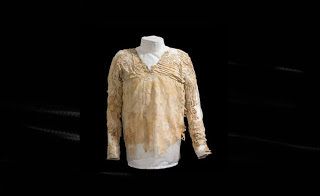 A piece of clothing found buried in an ancient Egyptian cemetery has been identified as the oldest known dress and the oldest woven garment in the world.
A piece of clothing found buried in an ancient Egyptian cemetery has been identified as the oldest known dress and the oldest woven garment in the world.The item is known as the Tarkhan dress. It was discovered in 1912 by one of the most famous Egyptologists in history – William Flinders Petrie. Petrie excavated the site of Tarkhan, located 50 km (31.07 miles) south of Cairo, in 1912 – 1913. The impressive textile was found in one of the tombs, which was a large mud-brick niched construction. The tomb was built during the First Dynasty (c. 3218–3035 BC).
A dirty bundle of linen from the tomb was sent to the Victoria and Albert Museum in London in 1977 for conservation. It was only then that the V-neck linen shirt (or dress) with pleated sleeves was discovered. It has been preserved in remarkable condition. Apart from this treasured item of clothing, there were also 17 other different qualities of textiles.
 A reconstruction of
Tarkhan tomb 2050
, where the Tarkhan dress was discovered. (
The Petrie Museum of Egyptian Archaeology UCL
)Radiocarbon Dating Confirms the ImportanceIn 2015, a team led by Dr. Michael Dee from the University of Oxford measured a 2.24mg sample of the dress. They decided to check the age of the textile by using radiocarbon dating. According to the journal Antiquity, linen textiles are very suitable for radiocarbon dating as they are composed of flax fibers. Sometimes, a problem appears due to the reuse of the material, but in this case recycling seemed to be unlikely.
A reconstruction of
Tarkhan tomb 2050
, where the Tarkhan dress was discovered. (
The Petrie Museum of Egyptian Archaeology UCL
)Radiocarbon Dating Confirms the ImportanceIn 2015, a team led by Dr. Michael Dee from the University of Oxford measured a 2.24mg sample of the dress. They decided to check the age of the textile by using radiocarbon dating. According to the journal Antiquity, linen textiles are very suitable for radiocarbon dating as they are composed of flax fibers. Sometimes, a problem appears due to the reuse of the material, but in this case recycling seemed to be unlikely.The results of the analysis were published this week (February 2016) in Antiquity. According to the presented results of the examination: “The radiocarbon determination obtained for the Tarkhan Dress (OxA-32331) is 4570±36 BP (δ13C = -24.8 ‰ PDB). This calibrates to a true age (Figure 2) of 3366–3120 BC (68% probability) or 3482–3102 BC (95% probability).”
 [image error]
[image error]
[image error]
[image error]Figure 2. Radiocarbon date for the Tarkhan Dress adjusted for the Nilotic seasonal effect. ( Dee et al. 2010 )These results confirm that the dress, which is one of the oldest examples of Egyptian clothing, is the oldest known dress and oldest woven garment in the world.
Archaeologists find oldest known trousers in the worldExperts restore 1,400-year-old shoes from a Chinese tombWhen it Came to Ancient Undergarments Less Was Often More Weaving the World of Ancient Mayan WomenThe Tarkhan Dress is currently a part of the collection of the UCL Petrie Museum of Egyptian Archaeology in London. Dr. Alice Stevenson, Curator at the UCL Petrie Museum of Egyptian Archaeology, told Past Horizons:
“The survival of highly perishable textiles in the archaeological record is exceptional, the survival of complete, or almost complete, articles of clothing like the Tarkhan Dress is even more remarkable. We’ve always suspected that the dress dated from the First Dynasty but haven’t been able to confirm this as the sample previously needed for testing would have caused too much damage to the dress. Although the result is a little less precise than is now routinely possible through radiocarbon dating, as the sample was so small, it’s clear that the linen for the dress was made at the cusp of the First Dynasty or even earlier.”
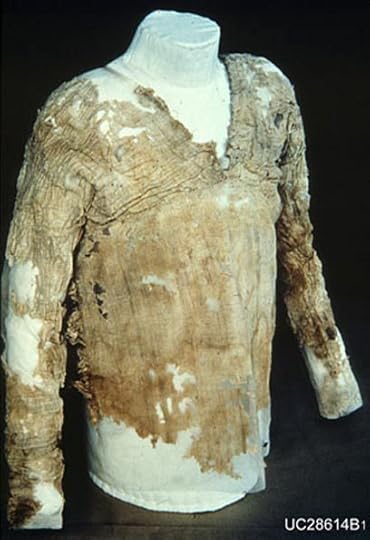 The Tarkhan dress. (
The Petrie Museum of Egyptian Archaeology UCL
)The Oldest Trousers and Shoes in the WorldPreviously, researchers believed that the oldest clothes were discovered in China. In 2014, a team of archaeologists led by Ulrike Beck and Mayke Wagner of the German Archaeological Institute in Berlin, excavated tombs in Yanghai in western China. There, they uncovered the remains of two nomadic herders and a pair of trousers with woven patterns, which were dated to be 3,000 years old. These are the oldest known pair of trousers found to date. The discovery also supports the theory about an evolution from tunics to trousers, which were more practical for horse-riders of the time.
The Tarkhan dress. (
The Petrie Museum of Egyptian Archaeology UCL
)The Oldest Trousers and Shoes in the WorldPreviously, researchers believed that the oldest clothes were discovered in China. In 2014, a team of archaeologists led by Ulrike Beck and Mayke Wagner of the German Archaeological Institute in Berlin, excavated tombs in Yanghai in western China. There, they uncovered the remains of two nomadic herders and a pair of trousers with woven patterns, which were dated to be 3,000 years old. These are the oldest known pair of trousers found to date. The discovery also supports the theory about an evolution from tunics to trousers, which were more practical for horse-riders of the time. [image error]
[image error]
[image error]
[image error]The oldest known trousers belonged to nomadic horsemen in Central Asia. ( M. Wagner/German Archaeological Institute )A few months later, in 2015, Chinese archaeologists announced the discovery and restoration of a pair of goat leather shoes. The shoes were discovered in tombs in Astana, the capital city of the ancient kingdom of Gaocheng. According to Xu Dongliang of Academia Turfanica in China, the shoes are 24 cm (9.45 inches) long, with the vamps, uppers and soles separately tailored. They are 1,400-years-old and were sewed together using animal sinew.
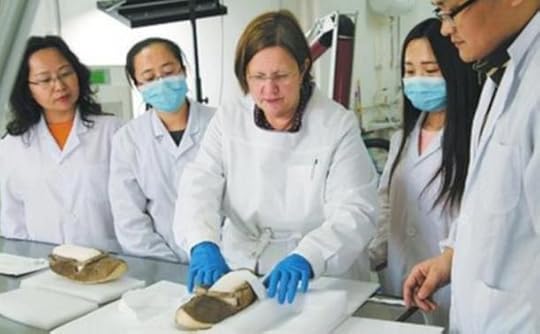 A Chinese archeological research institute restoring a pair of 1,400-year-old shoes unearthed from the Astana Tombs. (
The Institute of Archaeology, Chinese Academy of Social Sciences (IA CASS
))The past discoveries in China are impressive, however, the confirmation of the age of the shirt or dress from Egypt changes the history of textiles.
A Chinese archeological research institute restoring a pair of 1,400-year-old shoes unearthed from the Astana Tombs. (
The Institute of Archaeology, Chinese Academy of Social Sciences (IA CASS
))The past discoveries in China are impressive, however, the confirmation of the age of the shirt or dress from Egypt changes the history of textiles.Featured Image: The Tarkhan Dress. Source: The Petrie Museum of Egyptian Archaeology UCL
By Natalia Klimczak
Published on February 28, 2016 03:00
History Trivia - Scottish National Covenant signed
February 28
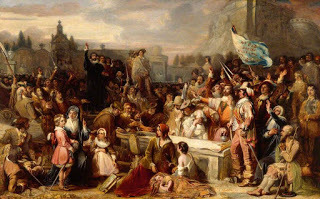
1638 The Scottish National Covenant was signed in Edinburgh, which denounced the attempts by Charles I to force the Scottish church to conform to English practices, at the same time urging loyalty to the king.

1638 The Scottish National Covenant was signed in Edinburgh, which denounced the attempts by Charles I to force the Scottish church to conform to English practices, at the same time urging loyalty to the king.
Published on February 28, 2016 00:30
February 27, 2016
Spanish Leak Reveals Hidden Chamber in Tutankhamun Tomb is Full of Treasures
Ancient Origins
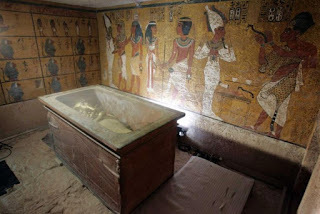 The Tourism Minister of Egypt Hisham Zaazou may have slipped up during a recent visit to Spain when he revealed startling information about the investigations into a hidden chamber in Tutankhamun’s tomb ahead of official press announcements due to take place in April. Zaazou said that the hidden chamber has been found to be full of treasures and will be the ‘Big Bang’ of the 21st century.
The Tourism Minister of Egypt Hisham Zaazou may have slipped up during a recent visit to Spain when he revealed startling information about the investigations into a hidden chamber in Tutankhamun’s tomb ahead of official press announcements due to take place in April. Zaazou said that the hidden chamber has been found to be full of treasures and will be the ‘Big Bang’ of the 21st century.According to the Spanish National daily newspaper, ABC, Zaazou made the sensational claims during a visit to Spain a few weeks ago.
"We do not know if the burial chamber is Nefertiti or another woman, but it is full of treasures," said Zaazou [via ABC] … “It will be a ‘Big Bang’, the discovery of the 21st Century".Investigations in Tutankhamun’s TombThe Ministry of Antiquities in Egypt launched high-tech analyses within the boy king’s tomb on November 4 after initial infrared scans of the walls of Tutankhamun’s tomb detected an area of greater heat, pointing to the presence of a hidden chamber.
The scans were designed to test out the theory by archaeologist Nicholas Reeves that the tomb of Tutankhamun contains two hidden chambers and that one of them is the final resting place of Queen Nefertiti. According to the Minister, the scans showed a 90 per cent likelihood that there was something behind the walls.
Nicholas Reeves first suspected hidden chambers in Tutankhamun’s tomb following a detailed examination of the Factum Arte scans of the artistic works on the walls of the tomb. Reeves noticed fissures that he thought indicated the presence of two sealed doors in the tomb’s north and west walls.
Press Announcement: Radar Scans Reveal Hidden Chamber in Tutankhamun Tomb with 90 Percent Certainty Excitement Mounts as New Infrared Scan in Tomb of Tutankhamun Suggests Hidden Chamber
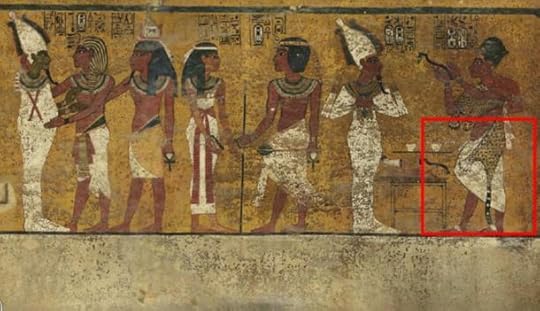 Scans of the north wall of King Tutankhamun's burial chamber have revealed features beneath the intricately decorated plaster (highlighted) a researcher believes may be a hidden door, possibly to the burial chamber of Nefertiti. Credit: Factum Arte.What lies within the secret chamber?According to Reeves, King Tutankhamun’s tomb was unfinished when he died unexpectedly as a teenager in 1332 BC. Consequently, he was hastily buried in the tomb of Queen Nefertiti, the principal wife of Akhenaten, who is believed to have fathered Tutankhamun with another wife. Reeves believes that Tutankhamun’s tomb displaced part of Nefertiti's tomb and assumed some of her burial goods and space.
Scans of the north wall of King Tutankhamun's burial chamber have revealed features beneath the intricately decorated plaster (highlighted) a researcher believes may be a hidden door, possibly to the burial chamber of Nefertiti. Credit: Factum Arte.What lies within the secret chamber?According to Reeves, King Tutankhamun’s tomb was unfinished when he died unexpectedly as a teenager in 1332 BC. Consequently, he was hastily buried in the tomb of Queen Nefertiti, the principal wife of Akhenaten, who is believed to have fathered Tutankhamun with another wife. Reeves believes that Tutankhamun’s tomb displaced part of Nefertiti's tomb and assumed some of her burial goods and space.However, Egypt’s Minister of Antiquities al-Damati believes otherwise. According to Agence France Press, Damati believes that any mummy buried in Tutankhamun’s tomb would be more likely to be Kiya, a wife of the pharaoh Akhenaten.
During his visit, Zaazou said there was also a theory that the chamber would be completely empty. However, he asserted that this has now been proven false. “It is not empty. It is full of treasures,” the minister said [via ABC]. “It will be an historic moment.”
Kiya - The Most Mysterious Woman of Amarna The Mysterious Disappearance of Nefertiti, Ruler of the Nile The Elusive Tomb of Queen Nefertiti may lie behind the walls of Tutankhamun's Burial Chamber
 [image error]
[image error]
[image error]
[image error]
Image showing the location of the two chambers from Dr. Reeves report. The upcoming radar scan will search for their existence. ( Daily Mail )Nile Magazine has questioned why Hisham Zaazou would abandon protocol to reveal such massive news prior to the official press announcements, which are due to take place in April.
“Of course, a cynical person could be forgiven for wondering why, in a government that is a stickler for protocol, the Tourism Minister was revealing such massive news rather than the Minister for Antiquities. It does seem remarkable that Mr. Zaazou has been so loose-lipped. Or could it be that the Minister is largely bluffing, hoping for a much-needed tourism boost?” questions Nile Magazine.
“However it is curious that the British Egyptologist who started all this, Nicholas Reeves, is currently in Luxor. Thankfully we don't have to wait all that long to find out. April will be here before we know it.”Featured image: The stone sarcophagus containing the mummy of King Tut is seen in his underground tomb. Credit: Nasser Nuri.
By April Holloway
Published on February 27, 2016 03:30
History Trivia - Theodosius makes Christianity sole religion of the Roman Empire
February 27
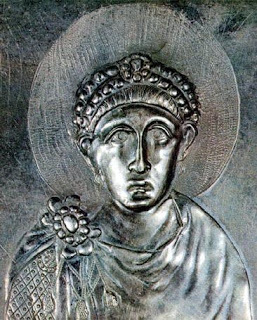
380 Roman emperor Theodosius declared the orthodoxy of the Nicene Creed, and made Christianity the sole religion of the empire

380 Roman emperor Theodosius declared the orthodoxy of the Nicene Creed, and made Christianity the sole religion of the empire
Published on February 27, 2016 02:00
February 26, 2016
3,000-Year-Old Egyptian Fingerprints found on Coffin Lid
Ancient Origins
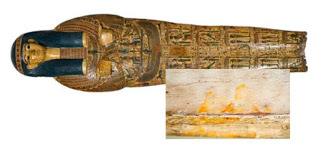 A set of ancient fingerprints have been found on the inner surface of a coffin lid dating back to 1,000 BC, which belonged to an Egyptian priest. The discovery brings to life our ancient past and draws us closer to the craftsmen that carved and painted the precious sarcophagi thousands of years ago.
A set of ancient fingerprints have been found on the inner surface of a coffin lid dating back to 1,000 BC, which belonged to an Egyptian priest. The discovery brings to life our ancient past and draws us closer to the craftsmen that carved and painted the precious sarcophagi thousands of years ago.
The BBC reports that the prints were identified by researchers with the Fitzwilliam Museum in Cambridge, England, ahead of a new exhibition called “Death on the Nile” on how Egyptian coffin design changed over 4,000 years.
It is believed that the prints belonged to the craftsman of the coffin, who handled the lid of the coffin before the varnish had dried, resulting in the preservation of his fingerprints until today.
The prints were “one of many small details that bring us closer to the ancient craftsmen,” a museum spokeswoman said.
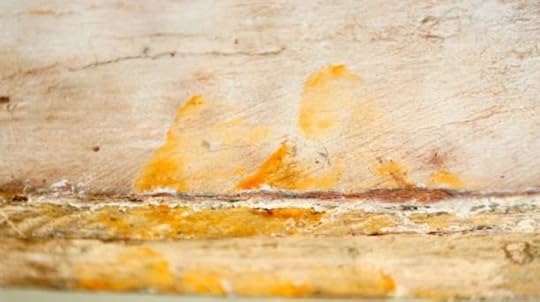 The fingerprints found on the inner lid of a 3,000-year-old coffin. Credit: The Fitzwilliam Museum, Cambridge.Uncovering Ancient FingerprintsThe study of ancient fingerprints is known as “paleodermatoglyphics” and allows archaeologists to peer into our ancestral past and learn more about the humans who inhabited the earth centuries ago.
The fingerprints found on the inner lid of a 3,000-year-old coffin. Credit: The Fitzwilliam Museum, Cambridge.Uncovering Ancient FingerprintsThe study of ancient fingerprints is known as “paleodermatoglyphics” and allows archaeologists to peer into our ancestral past and learn more about the humans who inhabited the earth centuries ago.
According to Forensic Outreach, “an ancient fingerprint is a historical snapshot of our ancestral past. They allow archeologists to study whoever came in contact with the material. This is not only the person who created the piece but a slew of others involved in manufacturing it. The type of material gives a lot of information. Prints uncovered from a ceramic artifact, bronze burial rings or historical document, give specific clues into the life of the person. Was he a craftsman or part of the educated elite?... ancient fingerprints are pervasive and can help unveil information about our ancestors that would otherwise remain a mystery.”
World’s Oldest FingerprintsThe newly discovered ancient Egyptian fingerprints, while rare, are not unique. Preserved fingerprints and palm prints have been found embedded in artifacts around the world dating back tens of thousands of years.
One of the oldest sets of fingerprints and palm prints found in Egypt dates back to 1,300 BC and belong to an Ancient Egyptian baker. The prints were identified in a preserved loaf of bread that had been left as food for the afterlife in a tomb in Thebes. The dry, arid climate had allowed the organic material to be impeccably preserved, along with the imprints of the baker who kneaded the dough while it was still soft.
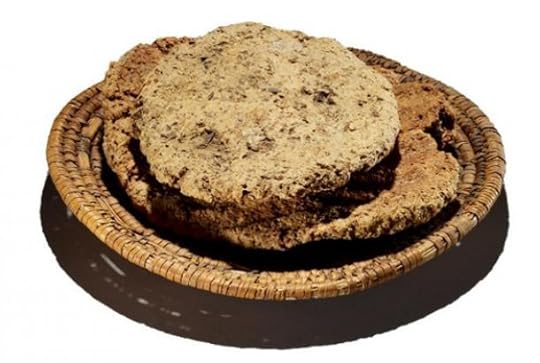 [image error]
[image error]
[image error]
[image error]
Ancient Egyptian bread, which retains its baker’s handprints ( abroad in the yard )Other records include 5,000-year-old fingerprints found on ceramic pot shards in the Stone Age settlement of Siretorp, Sweden; 10,000-year-old fingerprints found on fragments of clay objects at the Neolithic site of Boncuklu Hoyuk in Turkey; and 26,000-year-old child fingerprints found on a ceramic statuette in the Czech Republic known as the Venus of Dolní Věstonice.
Remarkably, archaeologists have also identified pre-human fingerprints belonging to a Neanderthal weapon maker who lived some 80,000 years ago in what is now the Königsaue region in Germany. His fingerprint was found on an organic substance used as a glue made from birch bark, which had been applied to attach a piece of flint to a wooden handle.
 From Left to Right: 10,000-year-old print found on clay fragment in Turkey, 26,000-year-old print found on Venus statuette in the Czech Republic, 80,000-year-old Neanderthal print (
abroad in the yard
)Featured image: The fingerprints were discovered by museum researchers on an inner coffin lid belonging to the priest Nespawershefyt from about 1000 BC. Credit: Fitzwilliam Museum, Cambridge.
From Left to Right: 10,000-year-old print found on clay fragment in Turkey, 26,000-year-old print found on Venus statuette in the Czech Republic, 80,000-year-old Neanderthal print (
abroad in the yard
)Featured image: The fingerprints were discovered by museum researchers on an inner coffin lid belonging to the priest Nespawershefyt from about 1000 BC. Credit: Fitzwilliam Museum, Cambridge.
By April Holloway
 A set of ancient fingerprints have been found on the inner surface of a coffin lid dating back to 1,000 BC, which belonged to an Egyptian priest. The discovery brings to life our ancient past and draws us closer to the craftsmen that carved and painted the precious sarcophagi thousands of years ago.
A set of ancient fingerprints have been found on the inner surface of a coffin lid dating back to 1,000 BC, which belonged to an Egyptian priest. The discovery brings to life our ancient past and draws us closer to the craftsmen that carved and painted the precious sarcophagi thousands of years ago.The BBC reports that the prints were identified by researchers with the Fitzwilliam Museum in Cambridge, England, ahead of a new exhibition called “Death on the Nile” on how Egyptian coffin design changed over 4,000 years.
It is believed that the prints belonged to the craftsman of the coffin, who handled the lid of the coffin before the varnish had dried, resulting in the preservation of his fingerprints until today.
The prints were “one of many small details that bring us closer to the ancient craftsmen,” a museum spokeswoman said.
 The fingerprints found on the inner lid of a 3,000-year-old coffin. Credit: The Fitzwilliam Museum, Cambridge.Uncovering Ancient FingerprintsThe study of ancient fingerprints is known as “paleodermatoglyphics” and allows archaeologists to peer into our ancestral past and learn more about the humans who inhabited the earth centuries ago.
The fingerprints found on the inner lid of a 3,000-year-old coffin. Credit: The Fitzwilliam Museum, Cambridge.Uncovering Ancient FingerprintsThe study of ancient fingerprints is known as “paleodermatoglyphics” and allows archaeologists to peer into our ancestral past and learn more about the humans who inhabited the earth centuries ago.According to Forensic Outreach, “an ancient fingerprint is a historical snapshot of our ancestral past. They allow archeologists to study whoever came in contact with the material. This is not only the person who created the piece but a slew of others involved in manufacturing it. The type of material gives a lot of information. Prints uncovered from a ceramic artifact, bronze burial rings or historical document, give specific clues into the life of the person. Was he a craftsman or part of the educated elite?... ancient fingerprints are pervasive and can help unveil information about our ancestors that would otherwise remain a mystery.”
World’s Oldest FingerprintsThe newly discovered ancient Egyptian fingerprints, while rare, are not unique. Preserved fingerprints and palm prints have been found embedded in artifacts around the world dating back tens of thousands of years.
One of the oldest sets of fingerprints and palm prints found in Egypt dates back to 1,300 BC and belong to an Ancient Egyptian baker. The prints were identified in a preserved loaf of bread that had been left as food for the afterlife in a tomb in Thebes. The dry, arid climate had allowed the organic material to be impeccably preserved, along with the imprints of the baker who kneaded the dough while it was still soft.
 [image error]
[image error]
[image error]
[image error]Ancient Egyptian bread, which retains its baker’s handprints ( abroad in the yard )Other records include 5,000-year-old fingerprints found on ceramic pot shards in the Stone Age settlement of Siretorp, Sweden; 10,000-year-old fingerprints found on fragments of clay objects at the Neolithic site of Boncuklu Hoyuk in Turkey; and 26,000-year-old child fingerprints found on a ceramic statuette in the Czech Republic known as the Venus of Dolní Věstonice.
Remarkably, archaeologists have also identified pre-human fingerprints belonging to a Neanderthal weapon maker who lived some 80,000 years ago in what is now the Königsaue region in Germany. His fingerprint was found on an organic substance used as a glue made from birch bark, which had been applied to attach a piece of flint to a wooden handle.
 From Left to Right: 10,000-year-old print found on clay fragment in Turkey, 26,000-year-old print found on Venus statuette in the Czech Republic, 80,000-year-old Neanderthal print (
abroad in the yard
)Featured image: The fingerprints were discovered by museum researchers on an inner coffin lid belonging to the priest Nespawershefyt from about 1000 BC. Credit: Fitzwilliam Museum, Cambridge.
From Left to Right: 10,000-year-old print found on clay fragment in Turkey, 26,000-year-old print found on Venus statuette in the Czech Republic, 80,000-year-old Neanderthal print (
abroad in the yard
)Featured image: The fingerprints were discovered by museum researchers on an inner coffin lid belonging to the priest Nespawershefyt from about 1000 BC. Credit: Fitzwilliam Museum, Cambridge.By April Holloway
Published on February 26, 2016 03:30
History Trivia - Birth of Wenceslas of Bohemia, Holy Roman Catholic German emperor
February 26
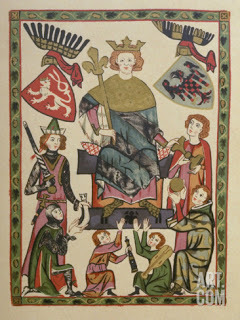
1361 Wenceslas of Bohemia, Holy Roman Catholic German emperor (1378-1400 was born. Not to be confused with the "Good" King of the same name, Wenceslas, son of Holy Roman Empeeror Charles IV, was a peace-loving but incompetent ruler who was unable to prevent the frequent conflicts in Germany. His power as King of Bohemia and Germany fluctuated until he was little more than a figurehead. He died, childless, in 1419, whereupon the crown passed to his half-brother Sigismund.

1361 Wenceslas of Bohemia, Holy Roman Catholic German emperor (1378-1400 was born. Not to be confused with the "Good" King of the same name, Wenceslas, son of Holy Roman Empeeror Charles IV, was a peace-loving but incompetent ruler who was unable to prevent the frequent conflicts in Germany. His power as King of Bohemia and Germany fluctuated until he was little more than a figurehead. He died, childless, in 1419, whereupon the crown passed to his half-brother Sigismund.
Published on February 26, 2016 01:00
February 25, 2016
Book Launch - Scribbler Tales Presents Escape from Berlin by Mary Ann Bernal

Scribbler Tales Presents Escape from BerlinMark Dresdner’s cover is blown, forcing him to flee East Germany, yet he refuses to leave the woman he loves. Finding the border crossing blocked, and the enemy closing in, will he evade capture or be forced to make the ultimate sacrifice?
Featuring Betrayal
Aelia gives herself completely to the man she loves, revealing a life-threatening secret, trusting her husband unconditionally, but is he deserving of her trust?
Deadly SecretsLysandra seeks a new life in America, hoping to forget her past, but an accidental meeting with a man who knows her true identity endangers her happiness.
Murder in the FirstAs judge, jury, and executioner, Bethel decides the fate of the man responsible for her plight, but things go terribly wrong and the predator becomes the prey.
The RitualDevona’s initiation into a modern-day pagan sect on All Hallows’ Eve sends the terrified young woman fleeing for her life amidst a raging storm. Escaping the sacrificial altar, will she survive the tempest?
Exclusive Bonus Material
ExcerptsThe Briton and the DaneThe Briton and the Dane: BirthrightThe Briton and the Dane: Legacy
The Briton and the Dane: ConcordiaThe Briton and the Dane: Timeline Available in print and digital formats at: AmazonSmashwords
Published on February 25, 2016 14:54
What was snuff?
History Extra
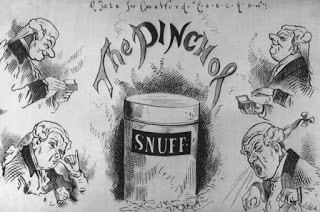
Poster from c1880 showing a barister during the stages of taking snuff. (Photo by Hulton Archive/Getty Images)
It was introduced into Spain following Columbus’s second voyage to the New World in the 1490s.
The supposed medicinal properties of tobacco saw it spread around Europe, rising in fortune in the 1560s when the French Queen Catherine de’ Medici declared it a wonder for headaches (it had been recommended by John Nicot, who later gave his name to nicotine).
The fashion spread throughout Europe, and by the 1700s snuff was considered a luxury product and mark of refinement. Sneezes were common after a pinch of snuff but they would be mocked as the sign of a beginner.
Though the stereotypical image of the snuff-taker is the Georgian dandy, it was also popular among women – George III’s queen was so fond of it that she earned the nickname ‘Snuffy Charlotte’.
As with most fashions it fell from favour, as new stimulants appeared.
Answered by one of our Q&A experts, Emily Brand

Poster from c1880 showing a barister during the stages of taking snuff. (Photo by Hulton Archive/Getty Images)
It was introduced into Spain following Columbus’s second voyage to the New World in the 1490s.
The supposed medicinal properties of tobacco saw it spread around Europe, rising in fortune in the 1560s when the French Queen Catherine de’ Medici declared it a wonder for headaches (it had been recommended by John Nicot, who later gave his name to nicotine).
The fashion spread throughout Europe, and by the 1700s snuff was considered a luxury product and mark of refinement. Sneezes were common after a pinch of snuff but they would be mocked as the sign of a beginner.
Though the stereotypical image of the snuff-taker is the Georgian dandy, it was also popular among women – George III’s queen was so fond of it that she earned the nickname ‘Snuffy Charlotte’.
As with most fashions it fell from favour, as new stimulants appeared.
Answered by one of our Q&A experts, Emily Brand
Published on February 25, 2016 03:00
History Trivia - Saint Walburga dies
February 25

777 Saint Walburga (Anglo-Saxon abbess and saint), patroness of sailors because her prayers calmed a stormy sea, and thereby saving a ship caught in its wake, died

777 Saint Walburga (Anglo-Saxon abbess and saint), patroness of sailors because her prayers calmed a stormy sea, and thereby saving a ship caught in its wake, died
Published on February 25, 2016 02:30
February 24, 2016
Did people take drugs in Tudor times?
History Extra
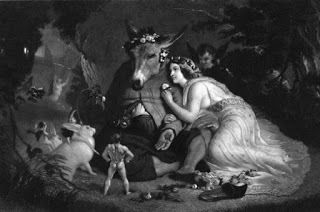
It is certainly plausible that drugs may have influenced some of the Bard’s work – A Midsummer Night’s Dream anyone? (Photbo by Kean Collection/Getty Images)
That said, of 24 pipes examined, two had traces of coca plant, which would have been extremely rare in 16th-century Stratford-upon-Avon.
Coca leaves – from which cocaine was first derived in the 19th century – were used as both stimulant and medicine by the Inca of Peru, but the Spanish showed no interest in introducing them to Europe.
More commonly imported was Cannabis sativa, yet this was primarily used to make hemp clothes and rope, rather than joints.
In Elizabethan England, the foremost recreational drugs were actually alcohol and tobacco.
The fact that cannabis and hallucinogenic nutmeg have been found in smoking pipes might suggest people were also getting high, but there are no written sources mentioning such habits.
As for Shakespeare, the evidence is especially suspect – doobie or not doobie, that is the question!
Answered by one of our Q&A experts, Greg Jenner.

It is certainly plausible that drugs may have influenced some of the Bard’s work – A Midsummer Night’s Dream anyone? (Photbo by Kean Collection/Getty Images)
That said, of 24 pipes examined, two had traces of coca plant, which would have been extremely rare in 16th-century Stratford-upon-Avon.
Coca leaves – from which cocaine was first derived in the 19th century – were used as both stimulant and medicine by the Inca of Peru, but the Spanish showed no interest in introducing them to Europe.
More commonly imported was Cannabis sativa, yet this was primarily used to make hemp clothes and rope, rather than joints.
In Elizabethan England, the foremost recreational drugs were actually alcohol and tobacco.
The fact that cannabis and hallucinogenic nutmeg have been found in smoking pipes might suggest people were also getting high, but there are no written sources mentioning such habits.
As for Shakespeare, the evidence is especially suspect – doobie or not doobie, that is the question!
Answered by one of our Q&A experts, Greg Jenner.
Published on February 24, 2016 03:30



